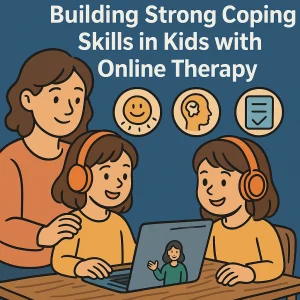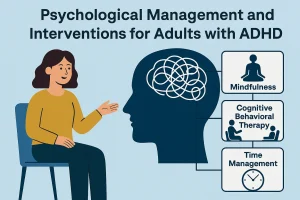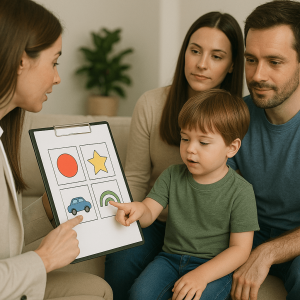Top 10 Techniques for Managing Inattention in Adults with ADHD
Last Updated: August 21, 2024
Navigating adult life with Attention-Deficit/Hyperactivity Disorder (ADHD) presents unique challenges, especially in managing inattention. This condition extends beyond childhood, affecting many adults who struggle with focus during tasks like meetings, multitasking at work, and maintaining daily routines. The symptoms—difficulty concentrating, organizing, and completing tasks—can lead to frustration and impact self-esteem. However, understanding ADHD and implementing effective strategies can enhance productivity, decrease stress, and improve overall quality of life. Let’s explore how adults with ADHD can find balance and thrive.
Self-Control Mechanism Technique
One of the most effective ways to manage inattention in adults with ADHD is by developing strong self-control mechanisms. Self-control, in this context, refers to the ability to regulate your thoughts, emotions, and behaviors, especially when distractions arise. This technique is crucial for staying on task, maintaining focus, and minimizing the impulsivity that often accompanies ADHD.
Why Self-Control Matters:
In a world filled with distractions—from constant notifications on our phones to the endless stream of information online—staying focused can be a challenge for anyone. However, for adults with ADHD, this challenge is even more pronounced. Strengthening your self-control can help you resist these distractions, enabling you to complete tasks more efficiently and with less stress.
Practical Steps to Enhance Self-Control:
- Mindfulness Practices: Incorporating mindfulness into your daily routine can significantly enhance your self-control. Simple practices like deep breathing, meditation, or even just taking a moment to pause before reacting can help you become more aware of your impulses and make more deliberate choices.
- Setting Clear Goals: Establishing clear, achievable goals for yourself can provide a sense of direction and purpose. When you know exactly what you need to accomplish, it’s easier to stay on track and resist the temptation to veer off course.
- Using Timers: A practical tool for managing inattention is the use of timers or alarms. By setting a timer for a specific amount of time—say 25 minutes using the Pomodoro Technique—you can focus on one task at a time, knowing that you’ll have a break soon. This method can help maintain concentration and improve productivity.
- Breaking Tasks Into Smaller Steps: Large tasks can often feel overwhelming, leading to procrastination. By breaking these tasks into smaller, more manageable steps, you can reduce the mental load and maintain focus on one thing at a time.
Also Read: How Behavioral Therapy Helps Kids with ADHD
Self-Control Mechanism Technique
Managing inattention in adults with ADHD can be challenging, but developing strong self-control mechanisms can make a big difference. Self-control helps you stay focused, resist distractions, and avoid impulsive decisions that can derail your day.
Why Self-Control is Important:
In today’s fast-paced world, distractions are everywhere—whether it’s a buzzing phone or an open social media tab. For adults with ADHD, these distractions can be particularly hard to ignore. Building self-control can help you stay on track and complete tasks more efficiently.
Simple Ways to Boost Self-Control:
- Practice Mindfulness: Mindfulness helps you stay present and aware of your thoughts and actions. Simple techniques like deep breathing or taking a moment to pause before reacting can help you manage impulsive urges.
- Set Clear Goals: Clear goals give you direction and help you focus on what’s important. When you know what you need to do, it’s easier to stay on task and avoid distractions.
- Use Timers: Setting a timer for short periods, like 25 minutes, can help you stay focused. The Pomodoro Technique, where you work for 25 minutes and then take a short break, is a great way to maintain concentration.
- Break Tasks Into Small Steps: Big tasks can feel overwhelming. Breaking them into smaller, manageable steps makes them less intimidating and helps you stay focused on completing one step at a time.
Mindfulness Meditation
Mindfulness meditation is a powerful tool for managing inattention and boosting focus, especially for adults with ADHD. By practicing mindfulness, you train your mind to stay present, helping you to reduce distractions and improve concentration.
1. What is Mindfulness?
Mindfulness is about being fully aware of the present moment—paying attention to your thoughts, feelings, and surroundings without judgment. It’s a simple yet effective way to calm your mind and bring your focus back to what’s important.
2. Benefits of Mindfulness Meditation:
For adults with ADHD, mindfulness can be particularly beneficial. It helps reduce stress, improves attention, and enhances emotional regulation. Regular practice can make it easier to manage the symptoms of ADHD and improve overall well-being.
3. Incorporating Pranayama and Yoga:
In addition to mindfulness meditation, practices like pranayama (breathing exercises) and yoga can further enhance your ability to stay focused. Pranayama helps control your breath, which in turn calms the mind. Yoga combines movement with mindfulness, helping you to stay present and connected to your body.
Simple Techniques to Practice Mindfulness Daily:
- Start with Your Breath: Take a few minutes each day to focus on your breath. Notice the sensation of air entering and leaving your body. If your mind starts to wander, gently bring it back to your breath.
- Body Scan Meditation: This involves mentally scanning your body from head to toe, paying attention to any sensations you feel. This practice helps you connect with your body and stay grounded in the present moment.
- Mindful Walking: As you walk, pay attention to the movement of your body and the sensations in your feet as they touch the ground. This simple practice can be done anywhere and is a great way to integrate mindfulness into your daily routine.
- Yoga and Pranayama: Set aside a few minutes each day to practice yoga and pranayama. Even simple poses and breathing exercises can make a big difference in helping you stay calm and focused.
Also read: Navigating Daily Challenges: Understanding ADHD in Adults
Structured Routine
Establishing a structured daily routine is one of the most effective strategies for managing inattention in adults with ADHD. A consistent routine provides the stability and predictability needed to stay on track, reduce stress, and boost productivity.
Why a Structured Routine is Important:
For adults with ADHD, unstructured days can feel overwhelming and chaotic, leading to procrastination and unfinished tasks. A well-defined routine helps create a sense of order, making it easier to focus on what needs to be done. It also minimizes the mental energy spent on deciding what to do next, allowing you to channel your energy more effectively.
Tips for Creating and Sticking to a Structured Schedule:
- Start with the Basics: Begin by setting consistent wake-up and bedtimes. A regular sleep schedule can significantly impact your ability to focus and manage your day.
- Prioritize Your Tasks: Identify your most important tasks for the day and schedule them during your peak productivity times. This ensures that your energy is directed towards the tasks that matter most.
- Break Down Your Day: Divide your day into manageable blocks of time. This could include work, exercise, meals, and relaxation. Breaking your day into chunks helps prevent overwhelm and makes it easier to stay focused.
- Use Visual Aids: Tools like calendars, planners, or apps can be incredibly helpful in keeping your schedule organized. Visual reminders help you stay on track and ensure that you don’t forget important tasks.
- Stay Flexible: While it’s important to stick to your routine, it’s equally important to allow for some flexibility. Life can be unpredictable, and being able to adapt without derailing your entire day is key to long-term success.
- Review and Adjust: Regularly review your routine to see what’s working and what’s not. Make adjustments as needed to ensure that your schedule continues to support your goals and well-being.
Task Management Tools
Managing tasks effectively is essential for adults with ADHD, and task management tools can be a game-changer in staying organized and focused. Tools like to-do lists, calendars, and productivity apps are designed to help you keep track of your tasks, prioritize them, and ensure that nothing falls through the cracks.
Overview of Task Management Tools:
- To-Do Lists: A simple to-do list is one of the most effective tools for managing daily tasks. By writing down everything you need to do, you can clear your mind and focus on one task at a time. Whether it’s a physical list or a digital one, having a to-do list helps you visualize your workload and stay on top of your responsibilities.
- Calendars: Calendars are essential for scheduling appointments, deadlines, and reminders. A well-maintained calendar ensures that you never miss an important date. Digital calendars, such as Google Calendar, offer the added benefit of setting up alerts and integrating with other apps to streamline your schedule.
- Productivity Apps: There are numerous apps designed to help with task management. Apps like Trello, Asana, and Todoist offer features like task prioritization, collaboration, and progress tracking. These apps can be customized to fit your personal workflow, making them a versatile tool for staying organized.
How to Use These Tools Effectively:
- Keep It Simple: Start with one or two tools that fit your needs. Overloading yourself with too many tools can be overwhelming. For example, use a to-do list for daily tasks and a calendar for long-term planning.
- Prioritize Tasks: Not all tasks are created equal. Use your to-do list or app to prioritize tasks based on urgency and importance. This way, you can focus on what needs to be done first without feeling overwhelmed by everything else.
- Set Reminders: Utilize the reminder features in your calendar or app to prompt you about upcoming tasks and deadlines. Setting reminders helps you stay on track, especially when managing multiple responsibilities.
- Review Regularly: At the end of each day or week, review your tasks and update your tools accordingly. Mark completed tasks, adjust deadlines if needed, and plan for the next day or week. Regular reviews help you stay organized and reduce the risk of tasks piling up.
- Stay Consistent: Consistency is key to making task management tools work for you. Integrate them into your daily routine, so using them becomes a habit rather than a chore. Over time, these tools will help you manage your ADHD symptoms more effectively by keeping your tasks and schedule in check.
Break Tasks into Smaller Steps
One of the most effective ways to manage inattention and overwhelm, especially for adults with ADHD, is by breaking tasks into smaller, more manageable steps. This approach, often referred to as the “chunking” method, simplifies complex tasks and makes them feel less daunting.
What is the “Chunking” Method?
The “chunking” method involves taking a large task and breaking it down into smaller, more achievable parts. Instead of focusing on the entire task, you tackle each smaller step one at a time. This approach not only makes the task seem more manageable but also helps maintain focus and motivation as you complete each chunk.
Examples of How to Break Down Complex Tasks:
- Example 1: Writing a Report
- Entire Task: Write a 10-page report.
- Chunked Steps:
- Research the topic.
- Create an outline.
- Write the introduction.
- Write the main sections (one section at a time).
- Write the conclusion.
- Review and edit the report.
- Example 2: Organizing Your Home Office
- Entire Task: Organize the home office.
- Chunked Steps:
- Clear off the desk.
- Sort and file important documents.
- Declutter shelves.
- Organize supplies in drawers.
- Clean and vacuum the space.
- Example 3: Preparing a Presentation
- Entire Task: Prepare a presentation for work.
- Chunked Steps:
- Choose a topic.
- Gather relevant information.
- Create slides for each section.
- Practice delivering the presentation.
- Make final adjustments and rehearse.
Benefits of Chunking:
- Reduces Overwhelm: Breaking a big task into smaller parts makes it feel more achievable, reducing the anxiety and stress that can come with tackling large projects.
- Improves Focus: By concentrating on one small step at a time, you’re less likely to get distracted and more likely to stay on track.
- Boosts Motivation: Completing small steps gives you a sense of accomplishment, which can boost your motivation to keep going.
Task Breakdown Example
| Task | Steps/Time Needed |
|---|---|
| Writing a Report | 1. Research the topic – 1 hour 2. Create an outline – 30 minutes 3. Write the introduction – 1 hour 4. Draft the main sections (one at a time) – 2 hours 5. Write the conclusion – 30 minutes 6. Review and edit – 1 hour |
| Organizing a Room | 1. Declutter the space – 45 minutes 2. Sort items into categories (keep, donate, trash) – 30 minutes 3. Clean surfaces (dust, vacuum) – 30 minutes 4. Organize items by category – 1 hour 5. Arrange furniture and decor – 1 hour 6. Final touches (add personal items, plants) – 15 minutes |
Healthy Lifestyle Choices
Making healthy lifestyle choices is crucial for managing ADHD symptoms and improving overall well-being. Diet, exercise, and sleep are three key factors that have a significant impact on attention, focus, and mental clarity.
Importance of Diet:
Your diet plays a major role in how well you can focus and manage your ADHD symptoms. A balanced diet rich in whole foods—such as fruits, vegetables, lean proteins, and whole grains—provides the nutrients your brain needs to function at its best. On the other hand, processed foods, sugary snacks, and junk food can lead to energy crashes and make it harder to concentrate.
Dietary Tips:
- Avoid Oil and Junk Food: Reducing or eliminating oily and junk foods from your diet can help stabilize your energy levels throughout the day. These foods often cause spikes and crashes in blood sugar, leading to inattention and mood swings.
- Include Omega-3 Fatty Acids: Foods rich in omega-3 fatty acids, like salmon, walnuts, and flaxseeds, have been shown to support brain health and improve focus.
- Stay Hydrated: Drinking plenty of water is essential for maintaining concentration and overall brain function. Dehydration can lead to fatigue and decreased alertness.
Importance of Exercise:
Regular physical activity is another powerful tool for managing ADHD. Exercise increases the levels of neurotransmitters like dopamine and serotonin, which are essential for attention and focus. It also helps reduce stress and improve mood, making it easier to manage daily tasks.
Exercise Tips:
- Incorporate Aerobic Activities: Activities like walking, running, swimming, or cycling are great for boosting brain function and improving attention.
- Practice Yoga: Yoga not only strengthens your body but also helps calm your mind, making it a perfect exercise for those with ADHD.
- Consistency is Key: Aim to exercise at least 30 minutes a day, most days of the week. Even short bursts of physical activity can make a big difference.
Importance of Sleep:
Sleep is essential for mental clarity and focus. Adults with ADHD often struggle with sleep issues, which can exacerbate symptoms of inattention and impulsivity. Establishing a regular sleep routine can greatly improve your ability to concentrate and manage your day.
Sleep Tips:
- Stick to a Sleep Schedule: Go to bed and wake up at the same time every day, even on weekends, to help regulate your body’s internal clock.
- Create a Relaxing Bedtime Routine: Engage in calming activities before bed, such as reading, taking a warm bath, or practicing deep breathing exercises.
- Limit Screen Time: Avoid screens (TV, phone, computer) at least an hour before bedtime, as the blue light can interfere with your sleep quality.
Healthy Lifestyle Choices
| Lifestyle Factor | Recommended Practice | ADHD Benefits |
|---|---|---|
| Diet | – Eat a balanced diet rich in whole foods (fruits, vegetables, lean proteins, whole grains) – Avoid junk food, sugary snacks, and oily foods | – Stable energy levels – Improved focus and concentration |
| Exercise | – Engage in 30 minutes of physical activity daily (e.g., walking, running, yoga, cycling) | – Increased dopamine production – Better mood regulation – Enhanced cognitive function |
| Sleep | – Aim for 7-9 hours of sleep per night – Maintain a consistent sleep schedule (same bedtime and wake-up time) | – Enhanced mental clarity and focus – Reduced impulsivity and hyperactivity – Improved emotional regulation |
Limiting Distractions
For adults with ADHD, distractions can be one of the biggest hurdles to maintaining focus and productivity. Whether at work or home, minimizing these distractions is essential for staying on task and completing your daily responsibilities.
Identifying Common Distractions:
The first step in limiting distractions is identifying what commonly pulls your attention away. Some of the most frequent distractions include:
- Digital Distractions: Notifications from your phone, social media, email alerts, and the internet are some of the most pervasive distractions in today’s world.
- Environmental Distractions: Noise from the TV, background conversations, and even cluttered spaces can make it difficult to concentrate.
- Internal Distractions: Thoughts, worries, or daydreams can also pull your focus away from the task at hand.
Strategies to Minimize Distractions at Work and Home:
- Create a Distraction-Free Workspace:
- At Work: Set up a designated workspace that is free from unnecessary clutter. Use noise-cancelling headphones or play white noise if you work in a noisy environment. Keep your desk organized with only the essentials in sight.
- At Home: Choose a quiet, well-lit area of your home for work or study. Inform your family members of your working hours to minimize interruptions.
- Manage Digital Distractions:
- Turn Off Notifications: Disable notifications on your phone and computer during work hours. Use apps that block distracting websites or limit your time on social media.
- Schedule Email Checks: Instead of constantly checking your inbox, set specific times during the day to read and respond to emails. This prevents you from being pulled away from your work every time a new email arrives.
- Use the Pomodoro Technique:
- Work in focused intervals (typically 25 minutes), followed by a short break. This method not only helps maintain concentration but also provides regular opportunities to recharge without drifting into distractions.
- Keep a Distraction Log:
- If you find yourself frequently distracted, keep a log of what’s pulling your attention away. This can help you identify patterns and develop strategies to minimize those specific distractions.
- Practice Mindfulness:
- Incorporating mindfulness practices, like deep breathing or short meditation sessions, can help you stay present and reduce internal distractions. When your mind starts to wander, gently bring your focus back to the task at hand.
- Set Clear Boundaries:
- If you’re working from home, set clear boundaries with family or roommates about when you’re available and when you’re not. Consider using a “Do Not Disturb” sign during focused work periods.
Cognitive Behavioral Techniques
Cognitive Behavioral Therapy (CBT) is a well-established approach that has been proven effective in helping individuals with ADHD manage symptoms like inattention, impulsivity, and poor focus. By understanding and changing negative thought patterns and behaviors, CBT can empower you to take control of your ADHD symptoms and improve your daily functioning.
What is CBT and How Does It Benefit ADHD?
CBT is a type of therapy that focuses on identifying and modifying unhelpful thoughts and behaviors. For adults with ADHD, CBT can help in several ways:
- Improving Focus: CBT techniques encourage you to break down overwhelming tasks into manageable steps, helping you stay focused and avoid procrastination.
- Managing Inattention: By developing awareness of how your thoughts influence your actions, you can learn to redirect your focus when your mind starts to wander.
- Enhancing Emotional Regulation: CBT helps in identifying triggers that cause emotional reactions, allowing you to respond more calmly and effectively.
Simple CBT Techniques to Improve Focus and Manage Inattention:
- Thought Journaling:
- Start by keeping a journal of your thoughts, especially when you notice your focus slipping or when you feel overwhelmed by tasks. Write down what you were thinking and how those thoughts affected your actions. This practice helps you become more aware of unhelpful thought patterns that may be contributing to inattention.
- Cognitive Restructuring:
- Once you’ve identified negative or unhelpful thoughts, challenge them by asking yourself questions like, “Is this thought true?” or “What evidence do I have for this belief?” Replace these negative thoughts with more positive and realistic ones that encourage focus and productivity.
- Task Simplification:
- Break down tasks into smaller, more manageable parts, a technique closely related to chunking. By simplifying tasks, you reduce the mental load and make it easier to stay focused on completing one step at a time.
- Behavioral Activation:
- This technique involves identifying tasks that you tend to avoid or procrastinate on and scheduling them into your day. By making a commitment to complete these tasks, you create a sense of accountability and are more likely to follow through.
- Mindful Breathing:
- Incorporating mindful breathing exercises can help ground you when you feel your mind wandering. Taking a few deep breaths and focusing on the present moment can help clear your mind and improve concentration.
Regular Breaks and Downtime
Taking regular breaks and allowing for downtime throughout your day is essential, especially for adults with ADHD. Continuous work without pauses can lead to mental fatigue, decreased focus, and burnout. Incorporating regular breaks can refresh your mind, boost productivity, and improve overall well-being.
Importance of Taking Breaks:
Breaks are not just about resting; they play a crucial role in helping you maintain focus and manage your energy levels. For adults with ADHD, breaks can help reset your attention, making it easier to return to tasks with renewed concentration. Downtime also allows your brain to process information, leading to better problem-solving and creativity.
Tips on Incorporating Regular Breaks into Your Day:
- Follow the Pomodoro Technique:
- Work for 25 minutes, then take a 5-minute break. After completing four cycles, take a longer break of 15-30 minutes. This method helps you stay focused while ensuring you get regular, structured breaks.
- Set Alarms for Breaks:
- Use alarms or timers to remind yourself to take breaks. It’s easy to lose track of time when you’re deep in work, so setting reminders can help you stick to your break schedule.
- Move Around During Breaks:
- Use your break time to stretch, walk, or do a quick exercise. Physical movement helps improve circulation and refreshes your mind, making it easier to return to work with a clear head.
- Practice Mindful Relaxation:
- During longer breaks, practice mindfulness or deep breathing exercises. This helps calm your mind and reduces stress, allowing you to recharge more effectively.
- Avoid Screen Time During Breaks:
- Instead of scrolling through social media or checking emails during breaks, do something that truly relaxes you, like reading a book, listening to music, or stepping outside for fresh air.
- Schedule Downtime:
- Beyond short breaks, make sure to schedule downtime into your day or week. This could be time spent on a hobby, socializing with friends, or simply relaxing. Downtime is important for mental health and helps prevent burnout.
Conclusion
Managing inattention due to adult ADHD can be challenging, yet achievable with the right strategies. We’ve explored ten practical techniques, from mindfulness to task management, designed to boost focus and organization. Not all methods will suit everyone, so it’s essential to experiment and find what fits you best. At Wellness Hub, we’re here to support you every step of the way with personalized guidance and resources. Begin with small steps, integrate these strategies into your daily life, and with consistent effort, you’ll find managing your ADHD symptoms increasingly manageable, leading to enhanced focus and a greater sense of control.
Frequently Asked Questions:
1. What are effective strategies to manage inattention in adults with ADHD?
Managing inattention in adults with ADHD can be improved by using techniques such as mindfulness meditation, establishing a structured routine, breaking tasks into smaller steps, using task management tools, and setting alarms and timers.
2. How does mindfulness meditation help with ADHD?
Mindfulness meditation helps adults with ADHD by improving focus and reducing stress. It trains the mind to stay present, which can make it easier to manage inattention and impulsivity.
3. Why is having a structured routine important for adults with ADHD?
A structured routine provides stability and predictability, helping adults with ADHD stay on track and manage their time better. It reduces overwhelm and improves productivity.
4. What are some task management tools that can help with ADHD?
Task management tools like to-do lists, calendars, and apps like Trello or Todoist help adults with ADHD organize their tasks, prioritize them, and keep track of deadlines.
5. How can breaking tasks into smaller steps help with ADHD?
Breaking tasks into smaller, manageable steps (also known as “chunking”) makes it easier to start and complete tasks, reducing overwhelm and improving focus for adults with ADHD.
6. What lifestyle changes can improve ADHD symptoms?
Healthy lifestyle choices, such as eating a balanced diet, getting regular exercise, and ensuring quality sleep, can significantly improve ADHD symptoms. Avoiding junk food and maintaining a consistent routine also helps.
7. How do alarms and timers benefit adults with ADHD?
Alarms and timers help manage time effectively by providing reminders to stay on track. They can be used to structure work periods, remind you to take breaks, and ensure tasks are completed on time.
8. What are common distractions for adults with ADHD, and how can they be minimized?
Common distractions include digital notifications, environmental noise, and internal thoughts. Minimizing these distractions can be achieved by creating a distraction-free workspace, using tools to manage digital interruptions, and practicing mindfulness.
9. How does Cognitive Behavioral Therapy (CBT) help with ADHD?
Cognitive Behavioral Therapy (CBT) helps adults with ADHD by addressing negative thought patterns and behaviors, improving focus, and teaching techniques to manage inattention and impulsivity.
10. Why are regular breaks important for managing ADHD?
Regular breaks are important because they help prevent mental fatigue and maintain focus. Taking short, consistent breaks allows adults with ADHD to recharge and return to tasks with renewed concentration.
About Author:
Lasya Vooturi,
Clinical Psychologist (A) & Behavioral Therapist
Lasya holds a Professional Diploma in Clinical Psychology from Amity University, where she deepened her understanding of psychological principles from March 2023 to March 2024. With over a year of dedicated experience as a Behavioral Therapist, Lasya has honed her skills in applying effective therapy techniques tailored to individual needs. Fluent in Telugu, Hindi, and English, she is adept at connecting with a diverse range of clients, ensuring comprehensive communication and understanding. Lasya’s approach is grounded in empathy and scientific rigor, making her a trusted ally in navigating mental health challenges.
Book your Free Consultation Today
Parent/Caregiver Info:
Client’s Details:
* Error Message








